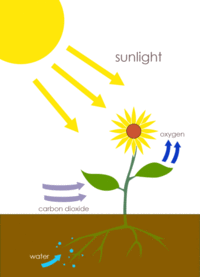Some science for the gardener
- This is Section 3 of the Gardening Seminar:Start your own garden. Comments or questions are appreciated. You can also write to John Eagles.
[[|320px|thumb|right|]]
Intro text
Photosynthesis
- Main article: Photosynthesis
All green plants can be seen as little factories that produce energy and food for all other living beings. The basic elements they need for this are water, air and sunlight. The process that runs in these countless factories is called 'photosynthesis.'
Photosynthesis takes place in a green pigment in plants, so-called chlorophyll, which absorbs sunlight. Plants are green because plants cannot absorb the green light that comes from the sun, though they absorb blue and red light. The green light is reflected back and makes the plant appear green.
Photosynthesis is the process by which green plants and some other organisms use sunlight to synthesize foods from carbon dioxide and water. It is the magical process that makes all our gardening and farming worthwhile. Air (carbondioxide) and water and sunlight are transformed into energy (sugar) and the structural element (carbon) for cells and oxygen to breathe.
Many plants survive in low light conditions. But when a plant is denied enough light, it attempts to grow taller in order to find light. The plant is taller but also weaker.
Photosynthesis is vital for all life on Earth that needs oxygen.
- Photosynthesis maintains normal levels of oxygen in the atmosphere
- It is the source of energy for building up the cells of an organism in which photosynthesis occurs, or as a source of food, it gives this energy to other organisms. For example, humans and animals eat plants.
Subsection
Text
Back
- Gardening Seminar:Start your own garden to go to the other sections of this seminar.
- Designing your garden to go to the former section of this seminar
Next section
- [[]]
See also
- a
References
External links
- a
Comments
- Coming soon

